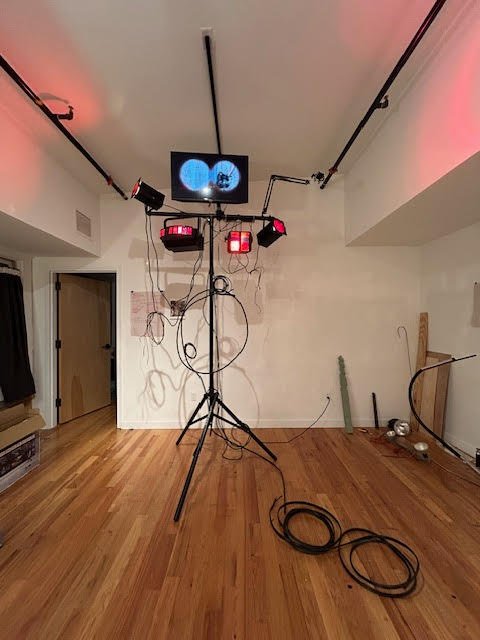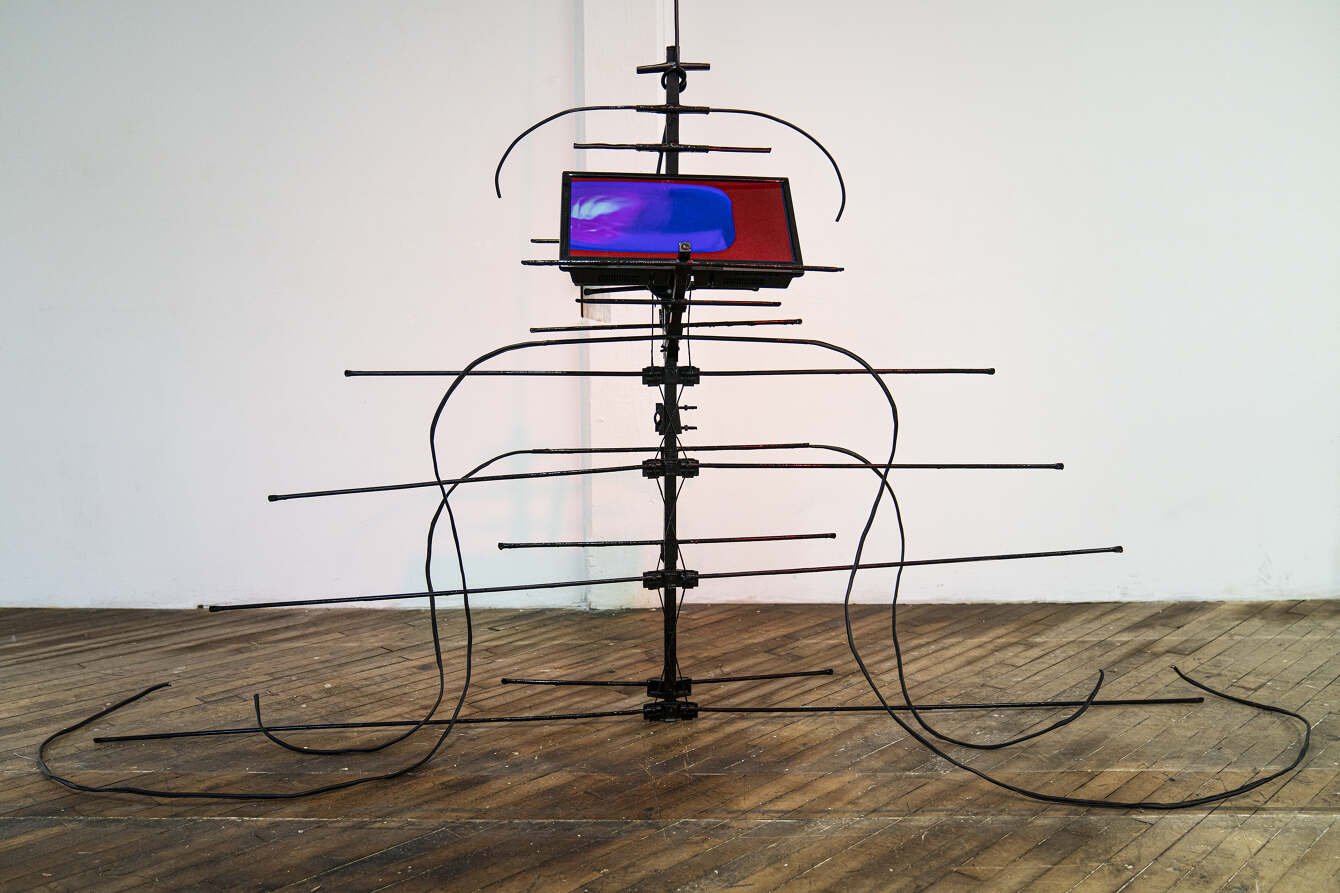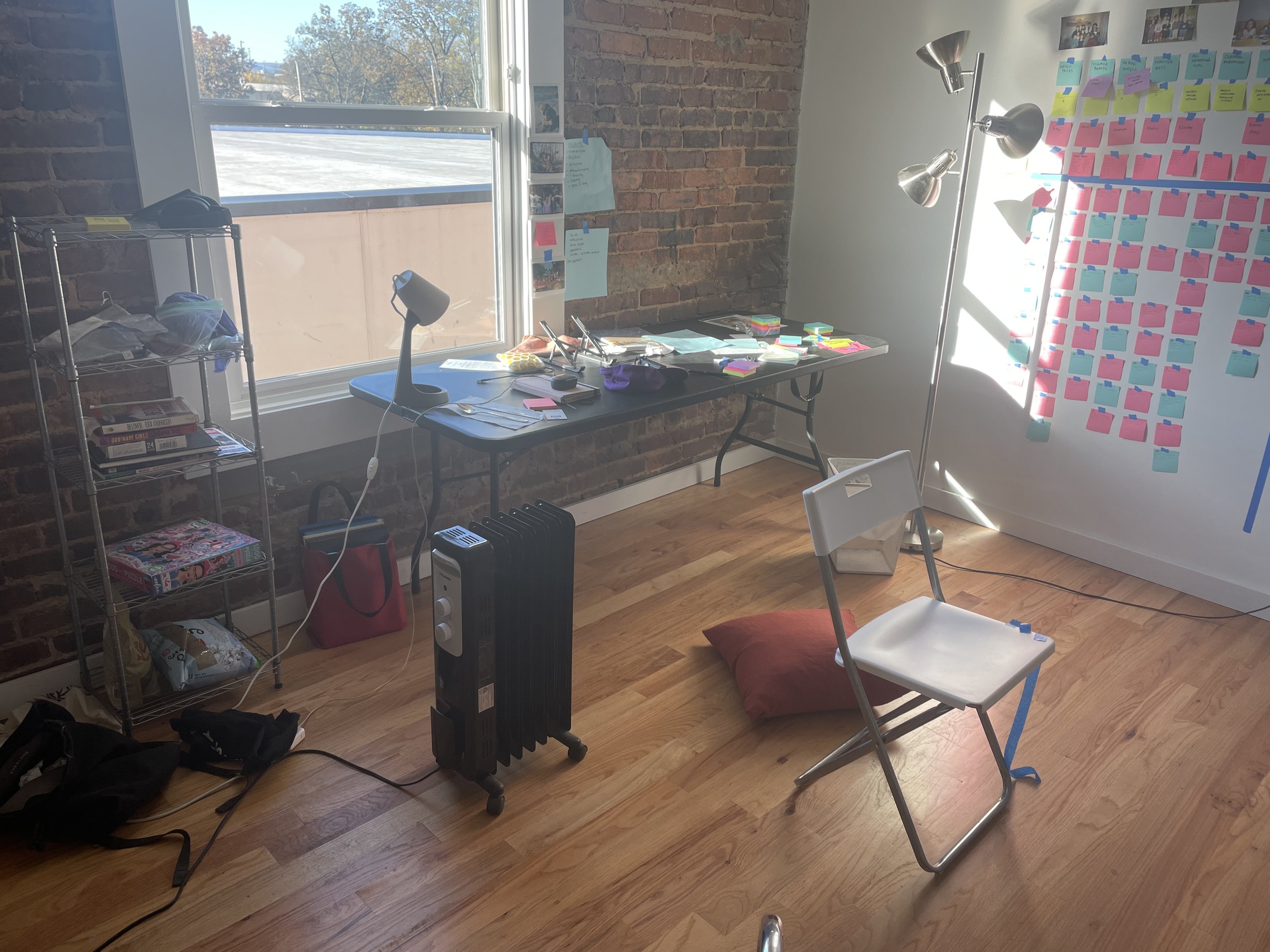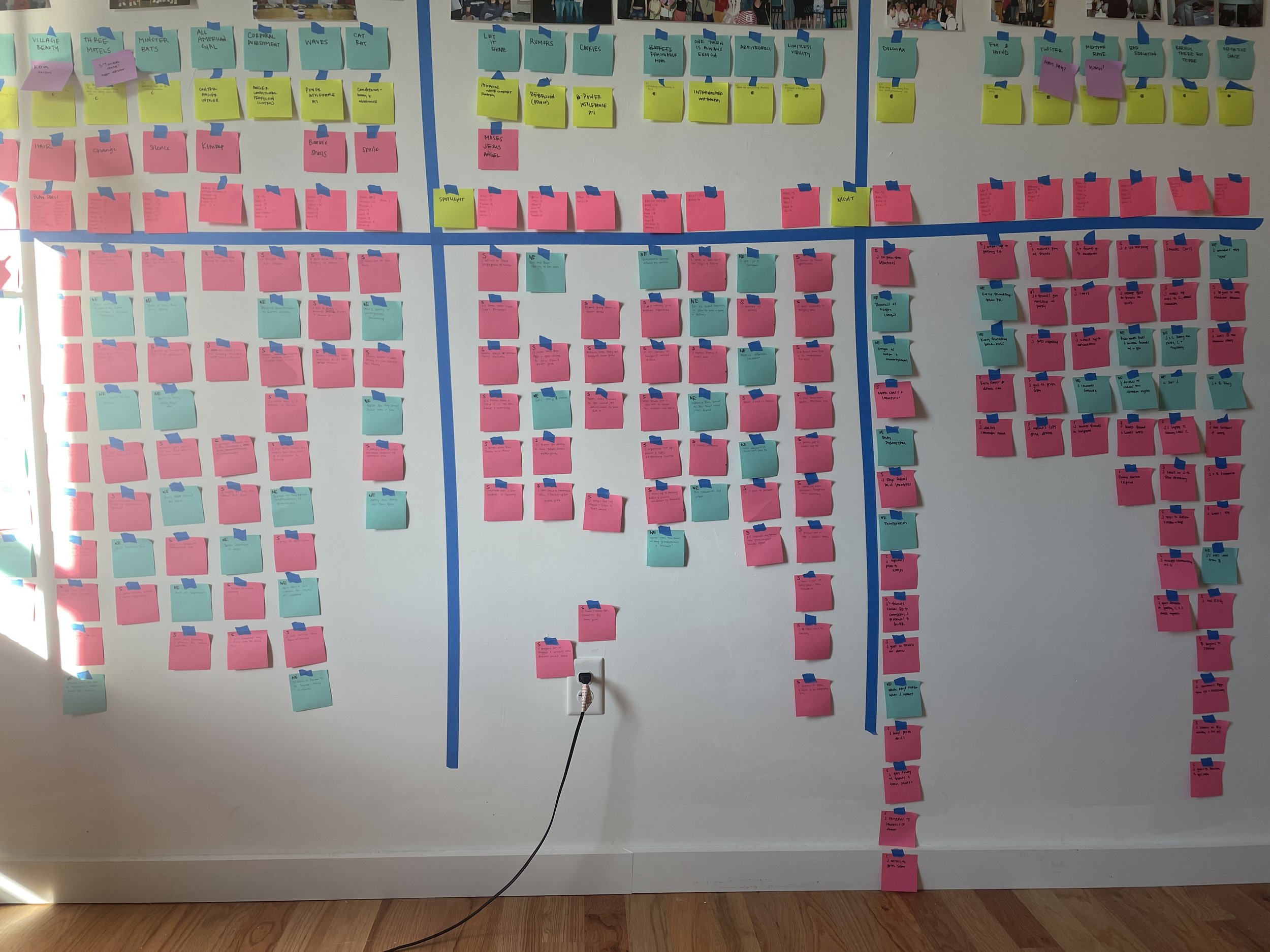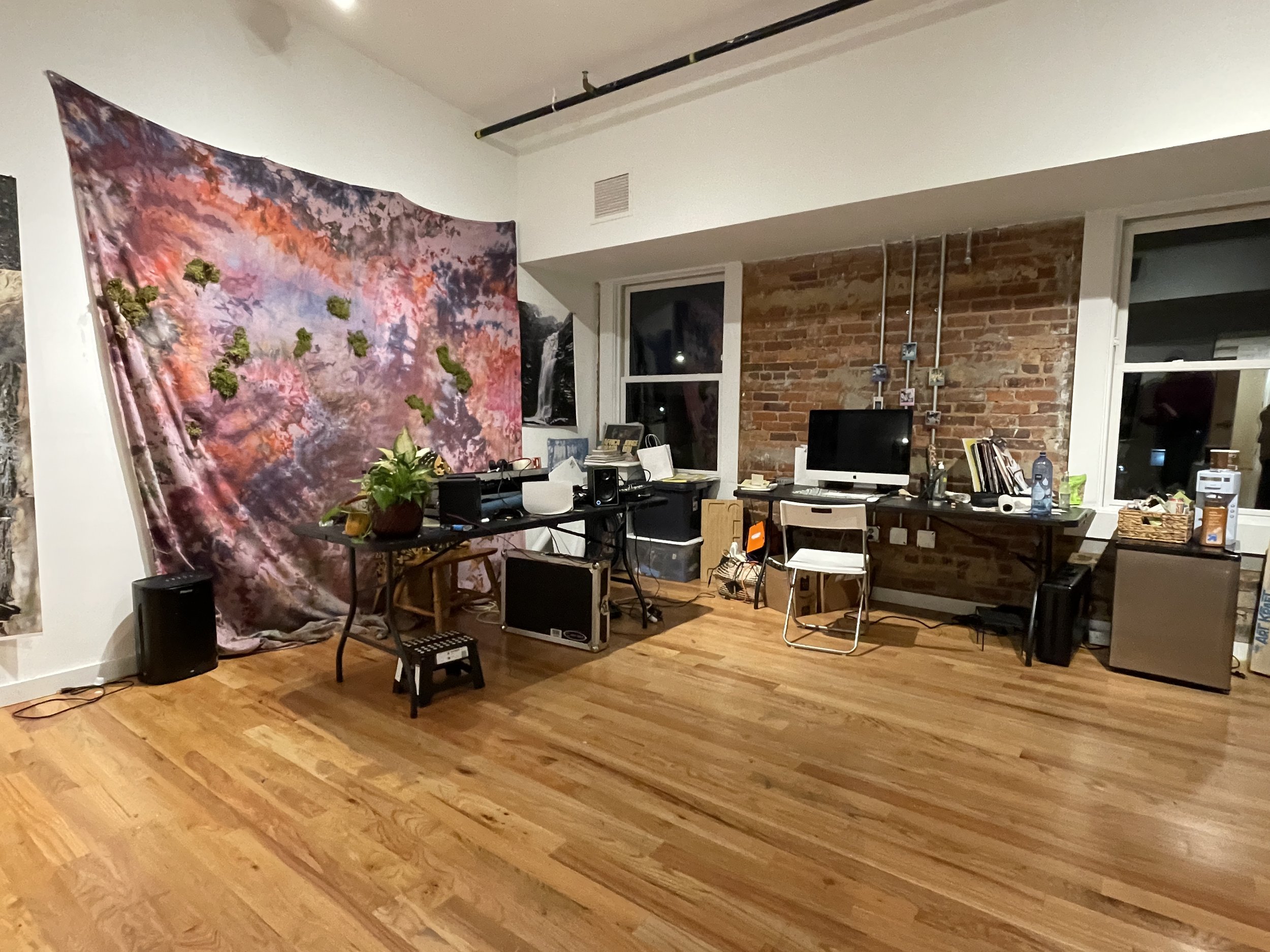Will Sutton and Jules Jackson, interviewed by Kate Greenwell
Will was a resident at Stove Works this past February, and Jules is a former resident (2023); each of their practices involves identity, expression, and masculinity and how they explore those aspects in today's world.
Will Sutton
Jules Jackson
Kate: Will, you just started your residency here at Stove Works, but you've been involved with them in the past. What are you gonna do with your time here in the next month?
Will: I think before I came here, I was feeling a lot less energized. And I think the Chattanooga Arts scene is kind of supported by Stove Works in a really strong way. As far as the city's art culture, I was feeling isolated, and Stove Works is a place that I align myself with and can successfully work within a community-based practice.
Jules: I agree; I think the community really helped, too. There is time here when you're receptive to the thoughts and perspectives of others. And if you play by yourself too much, I guess, in the studio, then you can get in your own head. There are certain things that you're not thinking about or considering, and you just don't know how to think about them. There is a kind of osmosis that takes place when you're in a group with other artists where you can influence each other in unsuspected ways and can see a different viewpoint of your work.
K: Will your work largely deals with identity and how that stems from community. I feel like you're largely integrated into the skate scene of Chattanooga and the art scene of Chattanooga. Do you feel like it's hard to blend those two things into your everyday practice?
W: As I'm working now, I'm personally interested in what people and artists do outside of their art practice. I think when I was in college I separated my identity as an artist from that of a skateboarder, or a music enjoyer, or as part of the local music scene.
It was not until I finished my senior thesis that I ultimately started combining those identities into my work. The aesthetics of skateboarding, the aesthetics of graffiti, and the aesthetics of aggressive music are the things that brought me into art-making. Those are the things that pushed me and formed my identity into becoming an artist. And then the fine arts provided me an opportunity to express those interests in a way that I think was academic. So I started in this skate culture, and then I ended up in fine arts. It's been about my journey to becoming who I am, what is my work about, what is my community, and how can my work exist in my community.
K: in your artist statement, you talk about young men struggling against masculinity and patriarchy in that skate community. How do you consider largely gendered activities in communities around you whenever you're making your works?
W: I think one experience that has changed me a lot is when I started working at the public library. I think I'm the only guy on the floor, and working in a space where I'm around troubled kids, the way that I respond and the way that young men respond to me, I was able to understand, or maybe kind of think more deeply around what are the reasons that cause those situations to arise, problematic behaviors of, you know, young men in general.
It's a difficult spot to be in because I love skateboarding but every culture has this kind of bad end and good end. Hardcore music, graffiti, and skateboarding all attract people that have a few screws loose. And being at Stove Works, working with other young artists, I feel like we can all relate to having a few screws loose.
The generation we’re in right now, we're all kind of working towards something together and I feel like with young men right now, it's a critical moment to try to think about what's going to happen to the future. I hate to bring it up, but you think about all the Andrew Tates and how young men are ingesting that media, and as the future of masculinity and gender changes, I hope there is a political pushback from the scenes of the hardcore world and music and graffiti to celebrate the disassembledge of gender norms.
Will Sutton, Boardslide, 2023, graphite on paper
K: Jules your work discusses masculinity as well, transmasculinity specifically. How are you processing those ideas through your practice?
J: It started from a place of wanting to make work about my own experiences as a trans man and looking to my own life to inspire the work because I feel like art is in dialogue with the rest of your life. As Will was saying, you have everything going on in your life outside of practice too. I'm interested in the bodily aspect of transition and making work about that and that ties in with my interest in cartoon forms, the cartoon body. I feel like this is maybe a little cliché to say, but I've always loved cartoons.
Jules Jackson, Foreshortened Jules, 2024, oil on canvas
J: It's been relatively recently that I have figured out the connection between my interest in cartoons and my interest in making work about my embodied experiences. Because during transition, you're autonomously taking the lead on the destiny of your own body and what happens to your body. If you're doing things like hormone replacement therapy or having surgeries, you're playing an active role in the kind of creation or recreation of yourself. I feel like that connects to kind of cartoon forms because the cartoon body is very round, it's very like, you know, bends and stretches, it occupies this unreal sort of place where it can be transformative, and that's one of the major ways that I'm exploring transmasculinity in my work. It's interesting to compare and look at the two of us and our work in dialogue because I feel like your work [Will] engages with some of the cultural signifiers of masculinity.
W: I think a lot about your [Jules] thesis work and how the werewolf was a signifier for masculinity, almost this Jekyll and Hyde, or werewolf aesthetic of American masculinity. This thing is so relevant to our social sphere; it has such a violent presence in American media. I think about my work through the lens of an adolescent teenager; how a teenage boy sees through this environment, and that’s where the claws come out, the werewolf comes out.
J: grrrrrrr
W: I think I lean towards cartooning as well because it’s a vessel that oversimplifies something complex.
J: Exactly. It has a flatness, and that flatness brings out a lot of complexity. By simplifying complex ideas, I feel like you can connect with people on a different level. And I think Scott McCloud's work and how he talks about the masking effect, how when you see a cartoon character that's more realistic, his theory is that you relate to them less because you perceive other people in those terms. You see other people as a sort of fully-fledged, realistic, three-dimensional being, but from the inside, in your own perspective, you kind of see yourself as a simplified entity, more of a conceptual entity. By simplifying the body, I want to give people an inroad.
K: Yeah, just like what you talked about earlier, leaving viewers to imagine their own identities.
J: For someone to be able to put themselves into someone else’s position, that's a path towards fostering empathy. In my case, foster empathy for the experience of undergoing gender transition. It's an unfamiliar kind of perspective for a lot of people to consider. So people have, at times, this reaction to seeing these images of surgery or bodily alterations. They almost cringe away from it a little bit at first. And there's nothing wrong with that. I think that that's a natural reaction to people; by bringing it out in the open and having a conversation about it, people can come to an understanding of the experience of going through a gender transition in surgeries. Talking about using the werewolf symbol as a symbol for masculinity and transmasculinity. It is a complex cultural symbol and often has violent connotations with media, like horror movies and popular culture. So, I wanted to bring it in and address that by getting away from its violent connotations and leaning more into its spiritual and transformative aspects.
W: The spiritual and emotional part behind the rebellious culture within skateboarding, graffiti, within heavy music. People are looking for expression and escape, looking for a way to speak and make their presence known. I think it goes back to transmasculinity and how you deal with moving into a masculine space that can be seen as violent and that is uncomfortable. The basis of masculinity is uncomfortable, the way that emotions are cramped.
J: I appreciate what you said about the problematic ways that masculinity exists within our society. I think that in my work, as well as my life, I want to imply a masculinity that doesn’t have that and to show that it can be done. I want to discharacterize traditional masculinity. There is a kinder way to live.
K: It seems like both your art practices have to do with a healing process and a reflection of your past.
W: Figurative social expression can respond to the world. I think within the language of visual arts, you can express the inutterable. A lot of the work I make, I do not have the words for it; It captures a specific idea. I think my practice has been a way of thinking through this complicated social sphere that we live in. In the end, we’re all just trying to cope.
J: I’ve always admired your [Will] ability to deal with change. I feel like your work entertains multiple possibilities at once.
W: I feel like my drawings are maps of experiences, maps of future, past, and present, and how they all happen within the same space. It’s about a visual residue that can be captured by drawings. This is a space I have struggled with in painting, there's something about drawings where I can stack and stack, and through that layering, I encapsulate the properties of honesty in my work.
J: In painting, when the image starts to become believable, you lose a lot of your plausible deniability; you have to make a decision and stick with it.
W: I think your work offers a really interesting, weird spot ….
J: Are you saying I'm a weirdo
W: haha, yeah. Your work is really cohesive in its cartoon style yet deceptive. This traditional American approach to a cartoon representation but it's painted under the guise of realism.
J: The work kind of mirrors something that I think about in other aspects, which is the ability to make a decision, and then you just kinda have to stick with it. It connects to the subject of transition. If you decide to do hormone therapy or gender replacement surgery, you're taking a bold stand. You're in it, and you're occupying a different place in society than you were before, and there's no real walk back. You're taking a bold, decisive stance within your society that gives society opportunity to define you as queer. Boldly and visually queer.
K: Thank you guys for letting me have the opportunity to have this conversation. Is there anything we should be looking for from you guys in the coming months?
J: I will have my work on display at Stove Works on May 3rd, and I will have my work at Coop Gallery in Nashville on June 1st.
W: Keep your eye on St. Andrews Center; we are trying to build some new art spaces in Chattanooga, so look out for that space.
Jules
Jules working in Stove Works studio space, 2023
Will working in Stove Works studio space, 2024
Jules and Will both help to run a collage workshop at St. Andrews Center, for more information visit exquisite_corps_ccc on Instagram.
You can follow their practices through
Willsuttonstudio on Instagram or www.willsuttonstudio.com
Julesinspace_ on Instagram









